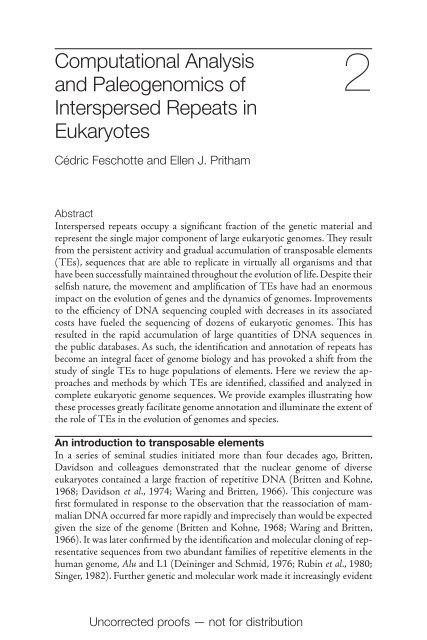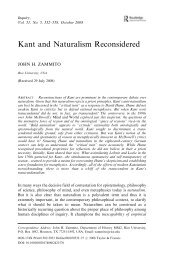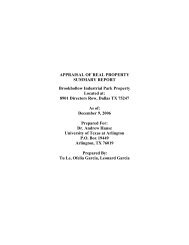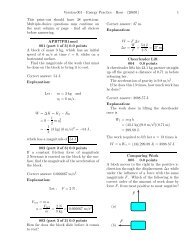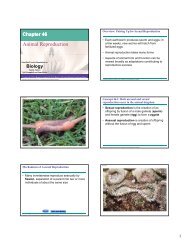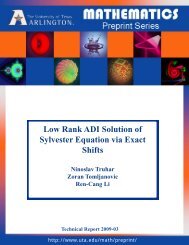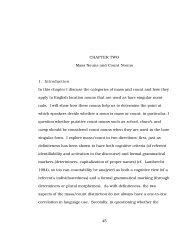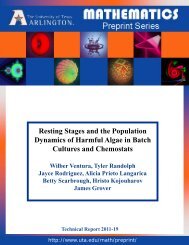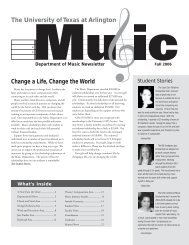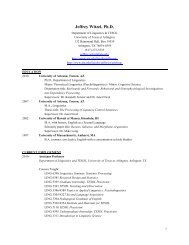Computational Analysis and Paleogenomics of Interspersed ...
Computational Analysis and Paleogenomics of Interspersed ...
Computational Analysis and Paleogenomics of Interspersed ...
You also want an ePaper? Increase the reach of your titles
YUMPU automatically turns print PDFs into web optimized ePapers that Google loves.
<strong>Computational</strong> <strong>Analysis</strong><strong>and</strong> <strong>Paleogenomics</strong> <strong>of</strong><strong>Interspersed</strong> Repeats inEukaryotes2Cédric Feschotte <strong>and</strong> Ellen J. PrithamAbstract<strong>Interspersed</strong> repeats occupy a significant fraction <strong>of</strong> the genetic material <strong>and</strong>represent the single major component <strong>of</strong> large eukaryotic genomes. They resultfrom the persistent activity <strong>and</strong> gradual accumulation <strong>of</strong> transposable elements(TEs), sequences that are able to replicate in virtually all organisms <strong>and</strong> thathave been successfully maintained throughout the evolution <strong>of</strong> life. Despite theirselfish nature, the movement <strong>and</strong> amplification <strong>of</strong> TEs have had an enormousimpact on the evolution <strong>of</strong> genes <strong>and</strong> the dynamics <strong>of</strong> genomes. Improvementsto the efficiency <strong>of</strong> DNA sequencing coupled with decreases in its associatedcosts have fueled the sequencing <strong>of</strong> dozens <strong>of</strong> eukaryotic genomes. This hasresulted in the rapid accumulation <strong>of</strong> large quantities <strong>of</strong> DNA sequences inthe public databases. As such, the identification <strong>and</strong> annotation <strong>of</strong> repeats hasbecome an integral facet <strong>of</strong> genome biology <strong>and</strong> has provoked a shift from thestudy <strong>of</strong> single TEs to huge populations <strong>of</strong> elements. Here we review the approaches<strong>and</strong> methods by which TEs are identified, classified <strong>and</strong> analyzed incomplete eukaryotic genome sequences. We provide examples illustrating howthese processes greatly facilitate genome annotation <strong>and</strong> illuminate the extent <strong>of</strong>the role <strong>of</strong> TEs in the evolution <strong>of</strong> genomes <strong>and</strong> species.An introduction to transposable elementsIn a series <strong>of</strong> seminal studies initiated more than four decades ago, Britten,Davidson <strong>and</strong> colleagues demonstrated that the nuclear genome <strong>of</strong> diverseeukaryotes contained a large fraction <strong>of</strong> repetitive DNA (Britten <strong>and</strong> Kohne,1968; Davidson et al., 1974; Waring <strong>and</strong> Britten, 1966). This conjecture wasfirst formulated in response to the observation that the reassociation <strong>of</strong> mammalianDNA occurred far more rapidly <strong>and</strong> imprecisely than would be expectedgiven the size <strong>of</strong> the genome (Britten <strong>and</strong> Kohne, 1968; Waring <strong>and</strong> Britten,1966). It was later confirmed by the identification <strong>and</strong> molecular cloning <strong>of</strong> representativesequences from two abundant families <strong>of</strong> repetitive elements in thehuman genome, Alu <strong>and</strong> L1 (Deininger <strong>and</strong> Schmid, 1976; Rubin et al., 1980;Singer, 1982). Further genetic <strong>and</strong> molecular work made it increasingly evidentUncorrected pro<strong>of</strong>s — not for distribution
32 |Feschotte <strong>and</strong> Prithamthat a large fraction <strong>of</strong> most metazoan genomes is composed <strong>of</strong> repetitive DNA.More recently, large-scale genome sequencing has ascertain the ubiquitous nature<strong>of</strong> repetitive DNA <strong>and</strong> its prevalence in most eukaryotic species (for review,Brookfield, 2005; Feschotte et al., 2002a; Kidwell, 2002). The human genome isa striking example: repetitive DNA accounts for more than half <strong>of</strong> the nuclearDNA <strong>and</strong> the aforementioned L1 <strong>and</strong> Alu repeat families alone occupy nearlyone third <strong>of</strong> the genomic space (IHGSC, 2001; Smit, 1999).Repetitive DNA can be divided into two distinct categories based on itsorganization within the genome: there are t<strong>and</strong>em <strong>and</strong> interspersed repeats.T<strong>and</strong>em repeats typically are amplified through slippage during replication,unequal crossing-over <strong>and</strong> gene conversion <strong>and</strong> are composed mainly <strong>of</strong> satelliteDNA <strong>and</strong> <strong>of</strong> simple sequence repeats, also referred to as mini- <strong>and</strong> microsatellites(for review, Schlotterer, 2000). The bulk <strong>of</strong> t<strong>and</strong>em repeats are primarilyrepresented by centromeric <strong>and</strong> pericentromeric satellite DNA whose evolutionaryorigin <strong>and</strong> dynamic remain poorly understood (Ugarkovic <strong>and</strong> Plohl, 2002).These highly repetitive regions are essentially excluded from large-scale genomesequencing efforts due to technological limitations in their cloning, sequencing<strong>and</strong> assembly. T<strong>and</strong>em repeats may account for a significant fraction <strong>of</strong> a givengenome (e.g. ~15% <strong>of</strong> the human genome) but interspersed repeats generallyrepresent the major component <strong>of</strong> the repetitive DNA (IHGSC, 2001). Mostinterspersed repeats are derived from mobile genetic elements or transposableelements (TEs). These are fragments <strong>of</strong> DNA that can move around <strong>and</strong> insertinto new chromosomal locations <strong>and</strong> are <strong>of</strong>ten duplicated in the process therebyincreasing their copy number (for a comprehensive review <strong>of</strong> transpositionmechanisms, see Craig et al., 2002). Thus, TEs or their remnants <strong>of</strong>ten representthe single largest component <strong>of</strong> eukaryotic genomes, accounting for 10% <strong>of</strong> thetiny genome <strong>of</strong> the nematode C. elegans, ~45% <strong>of</strong> the human genome <strong>and</strong> ~80%<strong>of</strong> the maize genome (Fig. 2.1).Traditionally eukaryotic TEs have been divided into two major classes accordingto whether their transposition intermediate is RNA (class 1) or DNA(class 2) (Capy et al., 1998; Finnegan, 1989). For class 1 elements, it is the element-encodedtranscript (mRNA), <strong>and</strong> not the element itself (as with class 2elements), that forms the transposition intermediate. Class 1 elements can befurther divided into two major subclasses with distinct mechanisms <strong>of</strong> transposition(Eickbush <strong>and</strong> Malik, 2002). The short <strong>and</strong> long interspersed elements(SINEs <strong>and</strong> LINEs) are (retro)transposed by reverse transcription <strong>of</strong> mRNAdirectly into the site <strong>of</strong> integration. In contrast the long terminal repeat (LTR)retroelements are reverse transcribed from RNA intermediates within virallikeparticles <strong>and</strong> are integrated as double-str<strong>and</strong>ed DNA molecules. This laststep <strong>of</strong> the transposition cycle <strong>of</strong> LTR retroelements is mechanistically similarto the integration <strong>of</strong> class 2 elements or DNA transposons. Class 2 elementstranspose directly via a DNA intermediate through the so-called cut-<strong>and</strong>-pastemechanism: the element is excised from the chromosome via a staggered doublestr<strong>and</strong>ed cleavage <strong>and</strong> reinserted elsewhere in the genome (Craig et al., 2002).Uncorrected pro<strong>of</strong>s — not for distribution
<strong>Computational</strong> <strong>Analysis</strong> <strong>of</strong> <strong>Interspersed</strong> Repeats | 33Figure 2.1 Genome size, amount <strong>of</strong> TE-derived DNA <strong>and</strong> amount <strong>of</strong> protein-codingDNA (non-TE proteins) in various eukaryotes with complete genome sequencesavailable. The data was compiled either from the corresponding papers reporting draftgenome sequences or from the following sources: Brassica (Zhang <strong>and</strong> Wessler, 2004)<strong>and</strong> X. Zhang, personal communication; rice Figure (Jiang 1 et al., 2004) <strong>and</strong> N. Jiang, personalcommunication; maize (Meyers et al., 2001); nematode, C.F., unpublished data. Thespecies are: slime mold, Dictyostelium discoideum; budding yeast, Saccharomycescerevisiae; fission yeast, Schizosaccharomyces pombe; Neurospora crassa;Arabidopsis thaliana; Brassica oleracea; rice, Oryza sativa; maize, Zea mays; nematode,Caenorhabditis elegans; Drosophila melanogaster; mosquito, Anopheles gambiae; seqsquirt, Ciona intestinalis; zebrafish, Danio rerio; fugu pufferfish Takifugu rubripes; mouse,Mus musculus.Besides the dramatic variation in total TE content among eukaryoticgenomes (see Fig. 2.1), there is also tremendous variation in the relative representation<strong>of</strong> the different classes (class 1 vs. class 2) <strong>and</strong> subclasses (LTR vs.non-LTR) <strong>of</strong> TEs among species (Fig. 2.2). For example, the compact genome<strong>of</strong> the bakers’ yeast contains only about 300 TEs <strong>and</strong> all are complete or fragmentedcopies <strong>of</strong> LTR-retrotransposons (Kim et al., 1998). At the other end <strong>of</strong>the spectrum, the human genome harbors about 3 million copies <strong>of</strong> TEs <strong>and</strong>3/4 can be classified as non-LTR retrotransposons (IHGSC, 2001). In contrast,class 2 DNA transposons are the most prevalent type <strong>of</strong> TEs in the rice <strong>and</strong>nematode genomes ( Jiang et al., 2004; Surzycki <strong>and</strong> Belknap, 2000). Othergenomes, such as those <strong>of</strong> the plant Arabidopsis thaliana (AGI, 2000), the fungiNeurospora crassa (Galagan et al., 2003) <strong>and</strong> the mosquito Anopheles gambiae(Holt et al., 2002) contain intermediate quantities <strong>of</strong> TEs (~10–30% <strong>of</strong> thegenomic DNA) with comparable proportions <strong>of</strong> DNA transposons, LTR <strong>and</strong>non-LTR retrotransposons (Fig. 2.2).Dramatically different assortment <strong>of</strong> TEs can also occur among closely relatedspecies. This was recently illustrated through a comparative genomic analysis<strong>of</strong> TEs in four species <strong>of</strong> Entamoeba protozoans (Pritham et al., 2005). Thegenomes <strong>of</strong> Entamoeba histolytica <strong>and</strong> E. dispar, two human parasites, containUncorrected pro<strong>of</strong>s — not for distribution
34 |Feschotte <strong>and</strong> PrithamFigure 2.2 Variation <strong>of</strong> TE composition across eukaryotic genomes. For each species,the relative proportion <strong>of</strong> DNA transposons, non-LTR <strong>and</strong> LTR retrotransposons wascalculated. The data were obtained as for Figure 2.1.Figure 2many dozen non-LTR retrotransposons, some <strong>of</strong> which recently amplified, butonly a h<strong>and</strong>ful <strong>of</strong> degenerate DNA transposons. The reptile parasite E. invadens<strong>and</strong> the free-living E. moshkovskii display the exact opposite assortment, withvery few non-LTR retrotransposons but a plethora <strong>of</strong> recently amplified DNAtransposons (Pritham et al., 2005). The causes <strong>and</strong> mechanisms underlying thedifferential success <strong>of</strong> various TE types in different species remain a puzzling <strong>and</strong>vastly unanswered question (for discussion see also Brookfield, 2005; Feschotte,2004; Kidwell, 2002; Zhang <strong>and</strong> Wessler, 2004).An important <strong>and</strong> virtually universal feature <strong>of</strong> TEs, regardless <strong>of</strong> their classification,is that the large majority <strong>of</strong> the elements found in a genome at anygiven time are not capable <strong>of</strong> transposition (Feschotte et al., 2002a; Smit, 1999).Indeed most <strong>of</strong> the elements are found as defective copies that cannot encodethe proteins necessary for their movement. For some elements this is their “natural”form (non-autonomous elements which must rely on autonomous elementspresent elsewhere in the genome, e.g. SINEs) while for others, this is the result<strong>of</strong> sequence degradation or deletion at the time <strong>of</strong> insertion (“dead-on-arrival”elements, i.e. most LINE copies). Consequently, once integrated, most TEswill never transpose again <strong>and</strong> can be regarded as molecular fossils (Smit et al.,1995).Regardless <strong>of</strong> their origin <strong>and</strong> <strong>of</strong> the mechanisms responsible for their inactivation,it is widely accepted that fossilized TEs, as a whole, do not assumefunction to the host. Consequently, inactive TE copies are progressively erodedby mutations accumulating at a neutral rate until they become unrecognizable<strong>and</strong> are ultimately erased or removed from the genome. With a few exceptions(Doak et al., 2003; Witherspoon et al., 1997), this appears to be the general pattern<strong>of</strong> evolution <strong>of</strong> TEs irrespective <strong>of</strong> the host species (e.g. Petrov et al., 2000;Robertson, 2002; MGSC, 2002). Given this fate, it is difficult to explain howUncorrected pro<strong>of</strong>s — not for distribution
<strong>Computational</strong> <strong>Analysis</strong> <strong>of</strong> <strong>Interspersed</strong> Repeats | 37<strong>and</strong> transposable elements previously described from other species. This is traditionallyachieved using basic local alignment search tools (BLAST, see Table2.1). For example, the program blastn is used to compare a nucleotide query to anucleotide database (e.g. non-redundant database, nr at GenBank), while blastxallows comparison <strong>of</strong> a nucleotide query translated into the six reading framesto a protein database (e.g. Swiss-Prot/UniProt at EMBL). Although thesepopular databases contain most <strong>of</strong> the described repeats <strong>and</strong> their encoded proteins,homology-based searches can be made more sensitive <strong>and</strong> comprehensiveby using a more specific database <strong>of</strong> “manually” curated repeat libraries. Suchrepeat databases are generally the result <strong>of</strong> years <strong>of</strong> meticulous mining <strong>of</strong> partialgenome sequences <strong>and</strong> <strong>of</strong> the TE literature. The most comprehensive referencelibraries are the Repbase libraries ( Jurka et al., 2005), which are compiled <strong>and</strong>maintained by the Genetic Information Research Institute (www.girinst.org).Currently, Repbase <strong>of</strong>fers reference libraries for about two dozens <strong>of</strong> eukaryoticspecies. Other specialized databases are <strong>of</strong>ten dedicated to particular types <strong>of</strong>repeats or organisms (Table 2.1).The major limitation <strong>of</strong> the homology-based approach is that only sequenceswith significant similarity to repeats previously described or depositedin Repbase will be identified. It could be a satisfying approach if the querysequence originates from a species that is very closely related to one for whicha comprehensive library is available. Otherwise, homology-based searches willtend to reveal only those repeats that are relatively intact <strong>and</strong> contain proteincodingsequences similar to those typically found in known TEs (e.g. reversetranscriptase, transposase … etc.). As our sequence coverage <strong>of</strong> the tree <strong>of</strong> lifeexp<strong>and</strong>s <strong>and</strong> the number <strong>of</strong> curated repeat databases increases, this approachwill become increasingly efficient at identifying the protein-coding regions <strong>of</strong>most typical repeats.De novo repeat identificationDe novo strategies are designed to identify repeated DNA within a genomesimply due to the repetitive nature sequences <strong>and</strong> not based on homology torepeats in a known library. Two basic approaches have been employed for denovo identification <strong>of</strong> repeats: query vs. query similarity searches <strong>and</strong> wordcounting/seed extension. The first relies on a self-comparison, for example anentire genome aligned to itself. This step generates a series <strong>of</strong> pairwise or localalignments (e.g. using BLAST or BLAST-like programs). Pairwise alignmentsare then converted into multiple alignments <strong>and</strong> clustering methods are used togroup related sequences into families, based on a pre-set or user-defined threshold<strong>of</strong> similarity <strong>and</strong> alignment length (Bao <strong>and</strong> Eddy, 2002). For example, weusually refer to sequences as members <strong>of</strong> the same family when they share atleast 85% nucleotide similarity over 75% <strong>of</strong> their length. Miropeats (Parsons,1995), RepeatFinder (Volfovsky et al., 2001) <strong>and</strong> RECON (Bao <strong>and</strong> Eddy,2002) are examples <strong>of</strong> programs using this approach (Table 2.1).Uncorrected pro<strong>of</strong>s — not for distribution
38 |Feschotte <strong>and</strong> PrithamOne disadvantage <strong>of</strong> these programs is that they are computationally intensive,requiring vast memory capacity <strong>and</strong> anywhere from hours to days <strong>of</strong>processing, depending on the algorithm or heuristic used <strong>and</strong> on the size <strong>and</strong>complexity <strong>of</strong> the query sequence. Another frequent issue is the relative lack <strong>of</strong>sensitivity <strong>of</strong> the programs used for the initial self-comparison (e.g. BLAST)or subsequent problems related to the clustering methods, which <strong>of</strong>ten lead toimprecise definition <strong>of</strong> the ends <strong>of</strong> the repeats.An alternative <strong>and</strong> increasingly popular approach involves word counting<strong>and</strong> seed extension. These methods bypass the need for whole genome alignmentsby building a set <strong>of</strong> repeat families starting with short sequence strings(seeds) representing repeats in the genome. These strings are progressivelyextended into a consensus sequence through dynamic comparisons <strong>of</strong> theirmultiple iterations in the query sequence. RepeatScout (Price et al., 2005) <strong>and</strong>ReAS (Li et al., 2005) are two recent programs that have been developed alongthose lines (Table 2.1).In a direct comparison with the query vs. query RECON package,RepeatScout was reported to require less computational power <strong>and</strong> to be moresensitive than RECON, defining more accurately the biological boundaries <strong>of</strong>the repeats (Price et al., 2005). Conveniently, several <strong>of</strong> these programs generatea consensus ancestral sequence for each repeat family identified in the query(RepeatScout, ReaS) <strong>and</strong>/or may provide the nucleotide positions <strong>of</strong> each repeat<strong>and</strong> the copy number per family (RECON). Some may also be able todistinguish t<strong>and</strong>em from interspersed repeat families. However, currently none<strong>of</strong> these programs permit a detailed biological classification <strong>of</strong> the repeats.De novo repeat identification methods are powerful because they willgenerate the most comprehensive catalogue <strong>of</strong> repeats present within a querysequence without a priori knowledge <strong>of</strong> the characteristics <strong>and</strong> classification<strong>of</strong> the repeats. One major pitfall <strong>of</strong> these approaches is that they can only beapplied to queries representing a considerable amount <strong>of</strong> sequence data (e.g.whole-genome shotgun sequences). A related problem is the identification <strong>of</strong>low-copy number repeat families (e.g. fewer than 10 copies). This is because<strong>of</strong> the increasing number <strong>of</strong> “false positive” (host-gene families <strong>and</strong> segmentalduplications) as the copy number cut-<strong>of</strong>f <strong>of</strong> the program is decreased. De novorepeat identification programs will also tend to miss or split composite repeats(i.e. repeats made <strong>of</strong> several independently repeated units) or families withhighly variable structure.Another persistent problem with de novo methods is a lack <strong>of</strong> accuracy inthe definition <strong>of</strong> the biological boundaries (ends) <strong>of</strong> the repeats. One <strong>of</strong> the reasonsfor this is that local sequence alignments (e.g. those generated by BLASTin a query vs. query approach) may not correspond to the biological ends <strong>of</strong>the repeats because <strong>of</strong> degraded or truncated copies or because <strong>of</strong> segmentalduplications covering more than one repeat. This causes a number <strong>of</strong> subsequentproblems in clustering related sequences into families. Although someprograms such as RECON have improved in their abilities to accurately detectUncorrected pro<strong>of</strong>s — not for distribution
<strong>Computational</strong> <strong>Analysis</strong> <strong>of</strong> <strong>Interspersed</strong> Repeats | 39the biological termini <strong>of</strong> repeats (Bao <strong>and</strong> Eddy, 2002), this remains an inherentlydifficult problem for the downstream steps <strong>of</strong> genome annotation, <strong>and</strong> inparticular for the automated classification <strong>of</strong> the repeats. In theory, short seedextension approaches such as those used by RepeatScout or ReaS should beless sensitive to this problem <strong>and</strong> generate more faithfully defined consensussequences. Nevertheless, these programs still appear to suffer from the problem<strong>of</strong> repeat fragmentation, in particular when low coverage whole genome shotgunsequences are used as input (N. Ranganathan <strong>and</strong> C. F., unpublished observation).Classification <strong>of</strong> the repeatsRecent advances in the development <strong>of</strong> de novo repeat identification tools havebeen fueled by the pressing need to automate the construction <strong>of</strong> repeat librariesto assist in the assembly <strong>of</strong> the multitude <strong>of</strong> genome sequencing projects.All <strong>of</strong> the programs described above, in particular when used in combination(Quesneville et al., 2005), have the potential to greatly accelerate the construction<strong>of</strong> consensus repeat libraries <strong>and</strong> as such they should largely fulfill the needsfor raw repeat masking <strong>and</strong> assisting in genome assembly. However, the outputproduced by programs such as RECON (Bao <strong>and</strong> Eddy, 2002) or RepeatScout(Price et al., 2005) provide little if any biological information on the repeatsthemselves <strong>and</strong> therefore cannot be used to annotate <strong>and</strong> classify the repeats. Atpresent, there is no program to completely automate this tedious yet biologicallyimportant phase <strong>of</strong> genome annotation.Developing such s<strong>of</strong>tware represents a very challenging issue in computationalbiology. Not only are there currently only a few experts whose knowledge<strong>of</strong> the elements can cover the extreme diversity <strong>of</strong> TEs, but also new groups <strong>of</strong>elements are continuously being discovered <strong>and</strong> existing groups being reclassified,merged, or subdivided. Consequently, the body <strong>of</strong> TE literature is enormous<strong>and</strong> rapidly exp<strong>and</strong>ing. As <strong>of</strong> September 2005 a single keyword searchin Medline using the combination “(retro)transposable OR (retro)transposon”retrieves over 21 000 publications, including ~1500 review articles! Thus, synthesizingthe diversity <strong>of</strong> TEs into a rational <strong>and</strong> comprehensive classificationupon which one could develop an automatic system <strong>of</strong> repeat annotation isextremely difficult.As mentioned earlier, TEs are divided into two classes depending on theirtransposition intermediate. Class 1 elements transpose via reverse-transcription<strong>of</strong> a transcribed RNA intermediate, while class 2 elements move directly througha DNA intermediate (Finnegan, 1989). The two classes are further dividedinto distinct subclasses <strong>and</strong> a plethora <strong>of</strong> clades <strong>and</strong> superfamilies using otherstructural features related to other aspects <strong>of</strong> their transposition mechanism.For example, non-LTR retrotransposons used a target-primed mechanism <strong>of</strong>transposition where reverse-transcription <strong>and</strong> integration are coupled, whileLTR retrotransposons are reverse transcribed within a viral-like particle <strong>and</strong> theresulting cDNA integrated in the genome as a DNA intermediate.Uncorrected pro<strong>of</strong>s — not for distribution
Table 2.1 Useful databases <strong>and</strong> tools to analyze repeatsUse URL/downloadDatabasesRepbase Update Eukaryotic DNA repeats http://www.girinst.org/repbase/index.htmlIS finder Insertion sequences (IS) from eubacteria <strong>and</strong> archaea http://www-is.biotoul.fr/ACLAME Prokaryotic mobile genetic elements, including transposons,plasmids <strong>and</strong> phagesTIGR Plant RepeatDBhttp://aclame.ulb.ac.be/Collection <strong>of</strong> plant repeats organized by genera http://www.tigr.org/tdb/e2k1/plant.repeats/Retrobase Depository for TE sequences identified by the Poulter lab http://biocadmin.otago.ac.nz/retrobase/home.htmHERVd Human endogenous retrovirus database http://herv.img.cas.cz/ICTVdB International committee on taxonomy <strong>of</strong> viruses http://www.ncbi.nlm.nih.gov/ICTVdb/Programs/toolsBLAST <strong>and</strong> related Nucleotide or protein sequence similarity searches http://www.ncbi.nlm.nih.gov/BLAST/WU-BLAST Nucleotide or protein sequence similarity searches http://BLAST.wustl.edu/ClustalW Multiple sequence alignment http://www.cf.ac.uk/biosi/research/bios<strong>of</strong>t/Downloads/clustalw.htmlPileUp Multiple sequence alignment http://helix.nih.gov/docs/gcg/pileup.html
Felsenstein’s list A pr<strong>of</strong>usion <strong>of</strong> links to various phylogeny programs http://evolution.genetics.washington.edu/phylip/s<strong>of</strong>tware.htmlCENSOR Repeatmasking http://www.girinst.org/censor/index.phpRepeatMasker Repeatmasking http://www.repeatmasker.org/RECON De novo repeat identification (query vs. query) http://www.genetics.wustl.edu/eddy/recon/RepeatFinder De novo repeat identification (query vs. query) http://cbcb.umd.edu/s<strong>of</strong>tware/RepeatFinder/REPuter De novo repeat identification (query vs. query) http://www.genomes.de/Miropeats De novo repeat identification (query vs. query) http://www.genome.ou.edu/miropeats.htmlRepeatScout De novo repeat identification (seed extension) http://repeatscout.bioprojects.org/ReAS De novo repeat identification (seed extension) ReAS@genomics.org.cnFindMITE Structure-based identification <strong>of</strong> MITEs http://jaketu.biochem.vt.edu/dl_s<strong>of</strong>tware.htmTRANSPO 1.0 Evolutionary analysis <strong>of</strong> MITEs <strong>and</strong> DNA transposons http://alggen.lsi.upc.es/MAK MITE analysis kit http://perl.idmb.tamu.edu/mak.htmTu lab TE toolset TE analysis toolset based on BLAST homology-based search http://jaketu.biochem.vt.edu/download.htmlLTR_STRUC Structure-based identification <strong>of</strong> LTR retrotransposons http://www.genetics.uga.edu/retrolab/data/LTR_Struc.htmlTSDfinder Identification <strong>of</strong> TE boundaries by locating TSD, primarily for L1LINEshttp://www.ncbi.nlm.nih.gov/CBBresearch/L<strong>and</strong>sman/TSDfinder/
42 |Feschotte <strong>and</strong> PrithamOne <strong>of</strong> the problems with this scheme is that one needs to have sufficientknowledge <strong>of</strong> the transposition mechanism <strong>of</strong> the elements for accurate classification.However relatively few elements have been investigated functionally<strong>and</strong> therefore in many cases the classification is made on the basis <strong>of</strong> sequencesimilarity with members for which the transposition mechanism has been experimentallydetermined <strong>and</strong> on the presence <strong>of</strong> conserved signatures <strong>and</strong> motifsin coding sequences (Capy et al., 1998). For example, the detection <strong>of</strong> codingsequences similar to reverse transcriptases in a given element strongly indicatesthat the element transpose through a RNA intermediate <strong>and</strong> thus should beclassified as a class 1 element. Unfortunately, as mentioned above, a very largefraction <strong>of</strong> TEs are nonautonomous <strong>and</strong>/or degenerate copies that have onlypartial or no coding capacity <strong>and</strong> thus cannot be classified upon protein similaritysearches. The classification <strong>of</strong> these elements (e.g. SINEs, MITEs) is moreambiguous as it generally relies on structural characteristics or weak sequencesimilarities limited to non-coding terminal regions important for transposition(Feschotte et al., 2002b; Ohshima <strong>and</strong> Okada, 2005).As an alternative to sequence similarity searches, a number <strong>of</strong> programs havebeen developed to mine particular group <strong>of</strong> TEs in genomic sequences basedon their structural features <strong>and</strong> assist in their classification <strong>and</strong> characterization.Some <strong>of</strong> these programs are listed in Table 2.1. For example, FindMITEis a C program designed to rapidly search a database for sequences that havethe characteristics <strong>of</strong> MITEs (Tu, 2001). The program searches the databasefor inverted repeats flanked by user-defined direct repeats within a specifieddistance range. One advantage <strong>of</strong> FindMITE is that one does not necessarilyneed a large amount <strong>of</strong> input sequence data <strong>and</strong> long-sized contigs to identifyrepresentatives <strong>of</strong> high copy number MITE families in any given species. IndeedFindMITE program was used to identify eight different MITE families in themosquito Anopheles gambiae based on a search <strong>of</strong> ~17 500 sequence tagged sites(STS) with an average size <strong>of</strong> only 829 bp (Tu, 2001). In fact, when a wholegenome sequence is available, it is advisable to restrict the FindMITE searchto a relatively small subsequence (depending on genome size <strong>and</strong> complexity)because the program is prone to generate a large number <strong>of</strong> false positives <strong>and</strong>requires a substantial amount <strong>of</strong> “visual” or semi-assisted downstream filtering.The analysis <strong>of</strong> c<strong>and</strong>idate MITEs identified by FindMITE can be complemented<strong>and</strong> extended using TRANSPO (Santiago et al., 2002) <strong>and</strong> MAK (Yang <strong>and</strong>Hall, 2003), two computational tools recently designed to assist in the evolutionarysequence analysis <strong>of</strong> MITE <strong>and</strong> other class 2 transposon families at thegenome-wide level (Table 2.1).Another alternative to traditional homology-based classification is the use <strong>of</strong>hidden Markov models (HMMs) as probabilistic models to detect <strong>and</strong> classifyTEs in genomic sequences (Quesneville et al., 2003). Interestingly, models basedon nucleotide composition biases were able to reliably discriminate TEs fromhost genes <strong>and</strong> class 1 from class 2 elements in three distant species (A. thaliana,C. elegans, D. melanogaster). Furthermore, the HMM method could distinguishUncorrected pro<strong>of</strong>s — not for distribution
<strong>Computational</strong> <strong>Analysis</strong> <strong>of</strong> <strong>Interspersed</strong> Repeats | 43the coding region <strong>of</strong> a TE from its non-coding region. These results suggest thatthis innovative approach could be very useful for the automated annotation <strong>of</strong>TE sequences. Recently, this method was combined with other tools to assemblea TE annotation pipeline that could reproduce faithfully a comprehensive annotationde novo <strong>of</strong> TEs in the D. melanogaster genome (Quesneville et al., 2005).Many repetitive <strong>and</strong> mobile elements may also be reticent to classification<strong>and</strong> annotation simply because they have not been characterized in sufficient detailor have not even been described as bona fide TEs. Some elements may simplylack defined common features or may not conform to any <strong>of</strong> the establishedrules <strong>of</strong> TE classification. This problem is illustrated by the recent discoveries<strong>of</strong> several atypical groups <strong>of</strong> TEs that remain difficult to classify despite theirwidespread distribution in eukaryotes. These include Helitrons (Kapitonov <strong>and</strong>Jurka, 2001), Penelope-like elements (Evgen’ev <strong>and</strong> Arkhipova, 2005), Cryptons(Goodwin et al., 2003) <strong>and</strong> Maverick elements (Feschotte <strong>and</strong> Pritham, 2005).The transposition mechanisms <strong>of</strong> these elements are not fully understood sotheir classification remains uncertain.The structure <strong>and</strong> coding capacity <strong>of</strong> these “exotic” elements suggest thatsome may represent novel TE classes or subclasses. For example, Helitrons appearto be related to a set <strong>of</strong> bacterial mobile elements <strong>and</strong> single-str<strong>and</strong>ed DNAviruses that replicate through a rolling-circle mechanism (Kapitonov <strong>and</strong> Jurka,2001). Thus the transposition <strong>of</strong> Helitrons likely involves displacement <strong>of</strong> asingle-str<strong>and</strong>ed DNA intermediate (Feschotte <strong>and</strong> Wessler, 2001). In contrast,the structural features <strong>and</strong> the conserved genes encoded by Mavericks indicatea possible evolutionary relationship with linear plasmids found in fungi <strong>and</strong>plants <strong>and</strong> with various double-str<strong>and</strong>ed DNA viruses that infect animals, mostclearly adenoviruses (Pritham et al., 2006). The transposition cycle <strong>of</strong> Mavericksis unclear at this point, but there is indirect evidence that the elements are integratedas double-str<strong>and</strong>ed DNA molecules, similarly to LTR retroelements <strong>and</strong>DNA transposons (Feschotte <strong>and</strong> Pritham, 2005; Pritham et al., 2006). Withthe rapid growth <strong>of</strong> the databases <strong>and</strong> the accumulation <strong>of</strong> newly discoveredtypes <strong>of</strong> elements, a revision <strong>of</strong> the current classification scheme has becomenecessary.Masking <strong>of</strong> repeats in nucleotide sequencesOnce a reference library <strong>of</strong> annotated repeats is assembled, it can be used toidentify all sequences related to each repeat family in the genome sequence <strong>of</strong>interest. This process is also referred to as repeat masking because the nucleotidesymbols identified as repetitive regions in the query sequence are replaced with“N” (or “X”) in the output sequence ( Jurka, 1998). Subsequently, masked regionsmay be “ignored” or eliminated all together to facilitate the process <strong>of</strong> genomeassembly, gene discovery <strong>and</strong> comparative genomic analyses. Repeat maskingalso allows related repeat sequences to be extracted automatically along withtheir positional information, which greatly assists in the study <strong>of</strong> their pattern<strong>of</strong> evolution, genomic distribution <strong>and</strong> so forth.Uncorrected pro<strong>of</strong>s — not for distribution
44 |Feschotte <strong>and</strong> PrithamThe efficiency <strong>and</strong> precision <strong>of</strong> genome masking strongly depends on thequality <strong>of</strong> the repeat library, both in terms <strong>of</strong> the accuracy <strong>of</strong> consensus sequences<strong>and</strong> <strong>of</strong> their faithful classification. Currently, the task <strong>of</strong> repeat annotation isoverwhelmingly dominated by the use <strong>of</strong> RepeatMasker, a program designednearly 10 years ago by Arian Smit <strong>and</strong> Phil Green. RepeatMasker remainsunpublished to date, but an online server allows one to run the program onany query sequence. The latest version (3.1.0 at the time <strong>of</strong> this publication) <strong>of</strong>the program is also freely downloadable through the server (see Table 2.1 forURL).Sequence comparisons in RepeatMasker are typically performed by theprogram cross_match developed by Phil Green. This program uses an implementation<strong>of</strong> the Smith-Waterman-Gotoh algorithm, which is known for itshigh sensitivity (compared to BLAST, for example). RepeatMasker can alsoaccommodate similarity searches powered by the WU-BLAST 2.0 package(Lopez et al., 2003). Wu-BLAST <strong>of</strong>fers less sensitivity than cross_match, butis less dem<strong>and</strong>ing in terms <strong>of</strong> computational power <strong>and</strong> processing time. TheRepeatMasker output also includes a table describing the location (nucleotidepositions), identity (repeat name <strong>and</strong> classification) as well as the length <strong>and</strong>nucleotide divergence <strong>of</strong> the aligned sequence to the consensus. This later featureis particularly useful to those interested in the biology <strong>of</strong> the repeats themselves,because it provides an instant estimation <strong>of</strong> the relative age <strong>of</strong> the repeat copyidentified (see below). The online server <strong>of</strong> RepeatMasker compares the querysequence to the Repbase libraries, but a locally installed version can be used withany sequence library such as a repeat catalogue compiled by the user.One person’s junk is another person’s treasure:interspersed repeats as markers <strong>of</strong> evolutionDespite the conundrum that repeats pose to genome assembly <strong>and</strong> annotation,the once popular view that all repeats are genomic junk has now become obsolete.Repeats provides a rich “fossil” record <strong>of</strong> ancient <strong>and</strong> recent genome history <strong>and</strong>represent an extraordinary source <strong>of</strong> information about molecular evolutionaryprocesses in general. Many recent l<strong>and</strong>mark publications illustrate how this“paleogenomic” record holds crucial clues about evolutionary events <strong>and</strong> forcesacting to shape the eukaryotic genome (some examples are developed below).Because they are generally evolving under no selective constraint, interspersedrepeats provide useful neutral markers for studying processes <strong>of</strong> mutation <strong>and</strong>selection. It is possible to recognize groups <strong>of</strong> TEs that arose at the same time<strong>and</strong> to follow their fates in different regions <strong>of</strong> the genome or in different species.Furthermore, most ancient TE insertions are very rarely excised (especiallyretrotransposons) <strong>and</strong> removed precisely <strong>and</strong> therefore they can be used as phylogeneticmarkers essentially free <strong>of</strong> homoplasy (Schmitz et al., 2005; Shedlock<strong>and</strong> Okada, 2000). Note: homoplasy refers to a collection <strong>of</strong> phenomena (e.g.convergence) that leads to similarities in character states for reasons other thaninheritance from a common ancestor.Uncorrected pro<strong>of</strong>s — not for distribution
<strong>Computational</strong> <strong>Analysis</strong> <strong>of</strong> <strong>Interspersed</strong> Repeats | 45Consensus sequences <strong>and</strong> ancestral repeat reconstructionThe consensus sequence is generated from a multiple alignment <strong>of</strong> a sample<strong>of</strong> interspersed copies assigned to the same TE family using a simple majorityrule for each base position in the alignment (Fig. 2.3). The consensus may befurther improved by manually correcting ambiguous or overlooked positionsthat could introduce stop codons <strong>and</strong> frameshifts in the ORF(s). Given thatall TEs from a family arose from a single or few active TE copies (also knownas source or master elements), the consensus can be considered a particularlyaccurate approximation <strong>of</strong> the sequence <strong>of</strong> the original master copy that gaverise to the family under consideration ( Jurka <strong>and</strong> Milosavljevic, 1991; Smit etal., 1995). This principle has been experimentally validated through the demonstrationthat the reconstructed consensus sequence <strong>of</strong> three different animalDNA transposase families restored their enzymatic activity in vitro <strong>and</strong>/or invivo (Ivics et al., 1997; Lampe et al., 1996; Miskey et al., 2003). Another earlysuccessful exploitation <strong>of</strong> the consensus approach was the resurrection <strong>of</strong> anextinct promoter for the human L1 retrotransposon based on a phylogeneticallyreconstructed consensus (Adey et al., 1994).An extension <strong>of</strong> the concept <strong>of</strong> consensus is that sequence comparisons <strong>of</strong>individual repeat copies to their consensus can be used to infer an approximateage <strong>of</strong> the repeat family, i.e. the time lapsed since transposition <strong>and</strong> insertion<strong>of</strong> the copies (Kapitonov <strong>and</strong> Jurka, 1996; Smit et al., 1995). This is because atCopy 1Copy 2Copy 3Copy 4Copy 5Copy 6Copy 7Copy 8CONS.66756756Figure 2.3 The concept <strong>of</strong> TE consensus sequence <strong>and</strong> its utility to infer the age <strong>of</strong> aTE family. In this schematic representation, eight related TE sequences are shown asthick horizontal lines. The consensus (CONS.) is deduced from a multiple alignment<strong>of</strong> TE sequences that vary at several Figure positions. 3 Most sequence variations occur atdiscrete positions, but some are also shared between copies. All shared <strong>and</strong> nonsharednucleotide changes may be used as phylogenetic characters to infer the relationship<strong>of</strong> the elements within the family (see Figure 2.4). Changes include single nucleotidesubstitutions (vertical ticks) <strong>and</strong> insertions (triangle above the sequence) <strong>and</strong> deletions(interrupted line) <strong>of</strong> variable size. The number <strong>of</strong> pairwise nucleotide substitutionsto the consensus is shown for each copy on the right h<strong>and</strong> side <strong>of</strong> the figure. Theaverage number <strong>of</strong> substitution to the consensus (here n = 6) can be used to infer theapproximate age <strong>of</strong> the family if the neutral rate <strong>of</strong> nucleotide substitution per year isknown for the host species. For example, if the neutral rate is 1 substitution per site permillion year, the family depicted here would be ~6 million year old.Uncorrected pro<strong>of</strong>s — not for distribution
46 |Feschotte <strong>and</strong> Prithamthe time <strong>of</strong> insertion, each repeat was in theory identical to the ancestral activefounder copy <strong>and</strong> therefore to the consensus. Following insertion, it is assumedthat the different copies accumulate discrete nucleotide substitution at a neutralrate. Thus the average percent divergence <strong>of</strong> the copies to their consensus is positivelycorrelated to the time elapsed since the bulk <strong>of</strong> the insertions occurred.The average percent divergence can be used to estimate the approximate age<strong>of</strong> the repeat family, provided that a neutral substitution rate per year has beendetermined for the lineage <strong>and</strong> timeframe under consideration.This method was employed to determine the approximate age <strong>of</strong> each <strong>of</strong>the three million TE-derived repeats dispersed in the human genome (IHGSC,2001). These elements fall into about 500 different families <strong>and</strong> subfamilies forwhich a consensus sequence was determined. For each family, the average sequencedivergence to the consensus was calculated assuming equal frequency <strong>of</strong>all nucleotide substitutions but excluding CpG positions in the consensus sincethese tend to evolve several orders <strong>of</strong> magnitude faster than other dinucleotides.This data was used to estimate the age <strong>of</strong> each family based on three-way speciescomparisons (“relative rate test”) <strong>and</strong> fossil data to calibrate the molecular clock(IHGSC, 2001).This analysis revealed several provocative findings. First, the majority(~55%) <strong>of</strong> the TEs recognizable in the human genome were inserted prior to theradiation <strong>of</strong> mammals, some 80–100 million year (myr) ago. Second, there wasan exceptional burst <strong>of</strong> TE activity ~40 myr ago, largely attributable to a majorwave <strong>of</strong> amplification <strong>of</strong> Alu SINEs. Since this peak, overall transpositional activityhas rapidly tumbled in the hominid lineage. Indeed, only a h<strong>and</strong>ful <strong>of</strong> TEfamilies (mostly members <strong>of</strong> the Alu <strong>and</strong> L1 groups) remain active in presenthuman populations (Deininger et al., 2003).In contrast, a similar analysis shows that > 85% <strong>of</strong> the TEs present in themouse genome were inserted specifically during the rodent radiation (MGSC,2002). These insertions were therefore specific to the rodent lineage. Thislineage-specific expansion <strong>of</strong> TEs now accounts for nearly one third (about818 Mb) <strong>of</strong> the mouse genome. In addition, age distribution analysis <strong>of</strong> mouseTE families reveals that transposition activity has remained roughly constantover the last 100 myr <strong>and</strong> that dozens <strong>of</strong> diverse families are still active in thisspecies (MGSC, 2002). This is in sharp contrast to the history <strong>and</strong> fate <strong>of</strong> TEsin the hominoid lineage, in agreement with the observation that the rate <strong>of</strong>spontaneous mutations caused by TE insertions is estimated to be ~60 timeshigher in mouse than in humans (Deininger et al., 2003). The reasons for theradically different levels <strong>of</strong> TE activity in the human <strong>and</strong> mouse lineage remainunclear, but they could be in part explained by recent fluctuations in populationsize <strong>and</strong> different life history <strong>and</strong> genetics <strong>of</strong> the species (MGSC, 2002).Phylogenetic analyses <strong>of</strong> transposable elementsThe examples above illustrate how the history <strong>of</strong> large populations <strong>of</strong> TEs,which <strong>of</strong>ten represents the single largest component <strong>of</strong> eukaryotic genomes,Uncorrected pro<strong>of</strong>s — not for distribution
<strong>Computational</strong> <strong>Analysis</strong> <strong>of</strong> <strong>Interspersed</strong> Repeats | 47can be deciphered through a relatively simple comparison <strong>of</strong> the divergence <strong>of</strong>individual repeat sequences to their respective family consensus sequences. Thisapproach can be complemented by phylogenetic analyses <strong>of</strong> separate families atthe whole-genome level. Such an analysis allows one to infer possible relationshipsamong members <strong>of</strong> the same family (e.g. existence <strong>and</strong> age <strong>of</strong> subfamilies)<strong>and</strong> to explore the amplification dynamics <strong>of</strong> the family (for review, Capy et al.,1998; Feschotte et al., 2002a).In order to carry out phylogenetic analyses, it is first necessary to producea multiple alignment <strong>of</strong> the TE sequences using programs such as ClustalX orPileUp (Table 2.1). The multiple sequence alignment is the raw material used forphylogenetic reconstruction, regardless <strong>of</strong> the method employed, so it is essentialto obtain the most reliable alignment. Therefore it is <strong>of</strong>ten necessary to edit <strong>and</strong>refine “manually” (i.e. by eye) multiple alignments in order to obtain biologicallysignificant phylogenetic trees. There are currently four major methods used toconstruct phylogenetic trees: (1) distance methods, such as Neighbor Joining,(2) maximum parsimony, (3) maximum likelihood, <strong>and</strong> (4) Bayesian analysis.It is beyond the scope <strong>of</strong> this review to describe the pros <strong>and</strong> the cons <strong>of</strong> eachmethod (for more information see Felsenstein, 2004), but it is important to keepin mind that no single method is the best for all circumstances. Phylogeneticanalyses can be carried out at the DNA level or at the protein level by aligningconceptual translations <strong>of</strong> protein coding DNA. This type <strong>of</strong> analysis has beenused extensively to decipher the evolutionary history <strong>of</strong> TE families <strong>and</strong> to classifynew elements based on clustering <strong>of</strong> elements with sequences representingknown families or superfamilies in phylogenetic trees (for a list <strong>of</strong> referencessee Capy et al., 1998; Feschotte et al., 2002a). An example <strong>of</strong> the application isshown in Fig. 2.4.In some instances, peculiar sequence or biological features <strong>of</strong> some TEgroups can also be exploited to infer the evolutionary history <strong>of</strong> individual TEfamilies or copies. For example, when a LTR retrotransposon inserts in the genome,its two LTRs are identical in sequence because both are copied from thesame template during the reverse transcription <strong>of</strong> the element. As time passes,nucleotide changes accumulate in each LTR in a relatively r<strong>and</strong>om fashion. If theaverage (neutral) rate <strong>of</strong> nucleotide substitution per year is known for the hostorganism, then sequence divergence between the LTRs provides an estimate<strong>of</strong> when the insertion occurred. For example, this method has been applied todate the numerous insertions <strong>of</strong> LTR retrotransposons nested in the intergenicregions that surround the maize alcohol dehydrogenase 1 gene (SanMiguel etal., 1998). This study reveals that several massive bursts <strong>of</strong> LTR retrotransposonactivity were responsible for a doubling <strong>of</strong> the maize genome within the past6 myr. A similar approach was used to determine the timing <strong>of</strong> various waves <strong>of</strong>retroviral integrations during primate evolution (for review, Sverdlov, 2000).One <strong>of</strong> the major drawbacks <strong>of</strong> the methods <strong>and</strong> approaches outlined aboveto determine the age <strong>and</strong> evolutionary history <strong>of</strong> TE is that they strongly relyon sequence comparisons <strong>and</strong> alignments. Moreover, the age <strong>of</strong> the elements isUncorrected pro<strong>of</strong>s — not for distribution
48 |Feschotte <strong>and</strong> PrithamG6G5G4G3G1G20.2Fot1PogoFigure 2.4 Phylogenetic analysis <strong>of</strong> TE sequences. This example shows an unrooteddistance tree constructed using the neighbor-joining method using the MEGA 3.1 s<strong>of</strong>tware.The phylogeny is based on a multiple alignment <strong>of</strong> protein sequences from Gemini DNAtransposons identified in the protozoans Entamoeba moshkovskii (represented by stars),E. invadens (dots) <strong>and</strong> E. terrapinae (square) Figure <strong>and</strong> 4 from transposases <strong>of</strong> the pogo/Fot1superfamily extracted from various animal, fungi <strong>and</strong> plant species. For a list <strong>of</strong> thesequences used for this alignment, see (Pritham et al., 2005). For clarity, the origin <strong>and</strong>accession number <strong>of</strong> the sequences have been omitted. In distance tree, the branchlength is proportional to the genetic distance between the sequences. The scale barrefers to 20% sequence divergence. The topology <strong>of</strong> the tree shown here emphasizesseveral aspects <strong>of</strong> TE dynamics. First, it shows the heterogeneity <strong>of</strong> Gemini sequences;they cluster into six distinct subfamilies (G1–6), while the Fot1 <strong>and</strong> pogo transposasesform separate groups. These groupings received strong statistical support in bootstrapanalysis (not shown). Second, it illustrates that Gemini sequences are closer to the Fot1group than to the pogo group. Third, it reveals the tempo <strong>and</strong> succession <strong>of</strong> Geminisubfamily amplification. Three Gemini subfamilies contain sequences from only E.moshkovski (G1–3) while the other three groups include a mix <strong>of</strong> sequences from two orthree species. This, along with shorter branch lengths, indicates that sequences withingroups G1 <strong>and</strong> G3 likely transposed in the E. moshkovskii lineage after its divergencefrom the other species, while the other sequences have a more ancient origin. Also,based on the branch lengths, elements within the G1 group amplified very recently in E.moshkovskii <strong>and</strong> are younger than elements <strong>of</strong> the G2 <strong>and</strong> G3 groups.estimated based on the availability <strong>of</strong> a neutral molecular clock, with the overlysimplistic assumptions that the clock ticks regularly over a given period <strong>of</strong> time<strong>and</strong> evenly across the genome <strong>and</strong> that most TE sequences are evolving under aneutral model <strong>of</strong> nucleotide substitution.Uncorrected pro<strong>of</strong>s — not for distribution
<strong>Computational</strong> <strong>Analysis</strong> <strong>of</strong> <strong>Interspersed</strong> Repeats | 49Concluding remarksImprovements to the efficiency <strong>of</strong> DNA sequencing coupled with decreases inits associated costs have fueled the sequencing <strong>and</strong> annotation <strong>of</strong> hundreds <strong>of</strong>genomes. This has resulted in the rapid accumulation <strong>of</strong> huge quantities <strong>of</strong> sequencesin the public databases. The comparison <strong>of</strong> closely related genomes hasmade clear the significance <strong>of</strong> the repetitive portion <strong>of</strong> the eukaryotic genome<strong>and</strong> revealed TEs as a major force shaping the structure <strong>of</strong> genes <strong>and</strong> genomes.As such, the identification <strong>and</strong> annotation <strong>of</strong> repeats has become an integralfacet <strong>of</strong> genome biology <strong>and</strong> has recently benefited from the development <strong>of</strong>several powerful computational tools to automate these processes. Two majorobstacles remain to further accelerate <strong>and</strong> improve repeat discovery <strong>and</strong> analysis.First, the programs used for de novo identification <strong>of</strong> repeats are performingpoorly at the task <strong>of</strong> accurately defining the biological ends <strong>of</strong> some repeats.Second, there is an urgent need to develop s<strong>of</strong>tware that can classify <strong>and</strong> annotaterepeats identified de novo—a necessity for the automation <strong>of</strong> repeat librarycuration. This represents an exciting challenge for the years to come for bothcomputational <strong>and</strong> transposon biologists because <strong>of</strong> the complexity <strong>and</strong> variety<strong>of</strong> TE structure <strong>and</strong> their intricate pattern <strong>of</strong> evolution. This would nonethelessbe a rewarding task as the accurate annotation <strong>of</strong> interspersed repeats will allowfor an improved assembly <strong>and</strong> annotation <strong>of</strong> genomes <strong>and</strong> will illuminate theextent <strong>of</strong> the role <strong>of</strong> TEs in the evolution <strong>of</strong> genomes <strong>and</strong> species.AcknowledgmentsResearch in the Feschotte <strong>and</strong> Pritham laboratories is supported by start-upfunds from the University <strong>of</strong> Texas at Arlington <strong>and</strong> by a Research EnhancementProgram grant (to C.F.).ReferencesAdey, N.B., Tollefsbol, T.O., Sparks, A.B., Edgell, M.H., <strong>and</strong> Hutchison, C.A. (1994).Molecular resurrection <strong>of</strong> an extinct ancestral promoter for mouse L1. Proc. Natl. Acad.Sci. USA 91, 1569–1573.Arabidopsis Genome Initiative (2000). <strong>Analysis</strong> <strong>of</strong> the genome sequence <strong>of</strong> the floweringplant Arabidopsis thaliana. Nature 408, 796–815.Arkhipova, I., <strong>and</strong> Meselson, M. (2005). Deleterious transposable elements <strong>and</strong> the extinction<strong>of</strong> asexuals. Bioessays 27, 76–85.Bao, Z., <strong>and</strong> Eddy, S.R. (2002). Automated de novo identification <strong>of</strong> repeat sequence familiesin sequenced genomes. Genome Res. 12, 1269–1276.Britten, R.J. (1996). DNA sequence insertion <strong>and</strong> evolutionary variation in gene regulation.Proc. Natl. Acad. Sci. USA 93, 9374–9377.Britten, R.J. (2004). Coding sequences <strong>of</strong> functioning human genes derived entirely frommobile element sequences. Proc. Natl. Acad. Sci. USA 101, 16825–16830.Britten, R.J., <strong>and</strong> Kohne, D.E. (1968). Repeated sequences in DNA. Hundreds <strong>of</strong> thous<strong>and</strong>s<strong>of</strong> copies <strong>of</strong> DNA sequences have been incorporated into the genomes <strong>of</strong> higher organisms.Science 161, 529–540.Brookfield, J.F. (2005). The ecology <strong>of</strong> the genome—mobile DNA elements <strong>and</strong> their hosts.Nat. Rev. Genet. 6, 128–136.Capy, P., Bazin, C., Higuet, D., <strong>and</strong> Langin, T. (1998). Dynamics <strong>and</strong> Evolution <strong>of</strong>Transposable Elements (Austin, TX, Springer-Verlag).Uncorrected pro<strong>of</strong>s — not for distribution
50 |Feschotte <strong>and</strong> PrithamChimpanzee Sequencing <strong>and</strong> <strong>Analysis</strong> Consortium (2005). Initial sequence <strong>of</strong> the chimpanzeegenome <strong>and</strong> comparison with the human genome. Nature 437, 69–87.Cordaux, R., Udit, S., Batzer, M.A., <strong>and</strong> Feschotte, C. (2006). Birth <strong>of</strong> a chimeric primategene by capture <strong>of</strong> the transposase gene from a mobile element. Proc. Natl. Acad. Sci.USA 21:8106–8106Craig, N.L., Craigie, R., Gellert, M., <strong>and</strong> Lambowitz, A.M. (2002). Mobile DNA II(Washington, DC, American Society for Microbiology Press).Daboussi, M.J., <strong>and</strong> Capy, P. (2003). Transposable elements in filamentous fungi. Annu. Rev.Microbiol. 57, 275–299.Daboussi, M.J., Daviere, J.M., Graziani, S., <strong>and</strong> Langin, T. (2002). Evolution <strong>of</strong> the Fot1transposons in the genus Fusarium: discontinuous distribution <strong>and</strong> epigenetic inactivation.Mol. Biol. Evol. 19, 510–520.Davidson, E.H., Graham, D.E., Neufeld, B.R., Chamberlin, M.E., Amenson, C.S., Hough,B.R., <strong>and</strong> Britten, R.J. (1974). Arrangement <strong>and</strong> characterization <strong>of</strong> repetitive sequenceelements in animal DNAs. Cold Spring Harb. Symp. Quant. Biol. 38, 295–301.Deininger, P.L., Moran, J.V., Batzer, M.A., <strong>and</strong> Kazazian, H.H., Jr. (2003). Mobile elements<strong>and</strong> mammalian genome evolution. Curr. Opin. Genet. Dev. 13, 651–658.Deininger, P.L., <strong>and</strong> Schmid, C.W. (1976). An electron microscope study <strong>of</strong> the DNA sequenceorganization <strong>of</strong> the human genome. J. Mol. Biol. 106, 773–790.Dewannieux, M., Esnault, C., <strong>and</strong> Heidmann, T. (2003). LINE-mediated retrotransposition<strong>of</strong> marked Alu sequences. Nat. Genet. 35, 41–48.Doak, T.G., Witherspoon, D.J., Jahn, C.L., <strong>and</strong> Herrick, G. (2003). Selection on the genes<strong>of</strong> Euplotes crassus Tec1 <strong>and</strong> Tec2 transposons: evolutionary appearance <strong>of</strong> a programmedframeshift in a Tec2 gene encoding a tyrosine family site-specific recombinase. Eukaryot.Cell 2, 95–102.Eichler, E.E., <strong>and</strong> Sank<strong>of</strong>f, D. (2003). Structural dynamics <strong>of</strong> eukaryotic chromosome evolution.Science 301, 793–797.Eickbush, T.H., <strong>and</strong> Malik, H.S. (2002). Origins <strong>and</strong> evolution <strong>of</strong> retrotransposons.In: Mobile DNA 2, N.L. Craig, R. Craigie, M. Gellert, <strong>and</strong> A.M. Lambowitz, eds.(Washington, DC, ASM Press), pp. 1111–1144.Evgen’ev, M.B., <strong>and</strong> Arkhipova, I.R. (2005). Penelope-like elements—a new class <strong>of</strong> retroelements:distribution, function <strong>and</strong> possible evolutionary significance. Cytogenet. GenomeRes. 110, 510–521.Felsenstein, J. (2004). Inferring Phylogenies (Sunderl<strong>and</strong>, MA, Sinauer Associates).Feschotte, C. (2004). Merlin, a new superfamily <strong>of</strong> DNA transposons identified in diverseanimal genomes <strong>and</strong> related to bacterial IS1016 insertion sequences. Mol. Biol. Evol. 21,1769–1780.Feschotte, C., Jiang, N., <strong>and</strong> Wessler, S.R. (2002). Plant transposable elements: where geneticsmeets genomics. Nat. Rev. Genet. 3, 329–341.Feschotte, C., Osterlund, M.T., Peeler, R., <strong>and</strong> Wessler, S.R. (2005). DNA-binding specificity<strong>of</strong> rice mariner-like transposases <strong>and</strong> interactions with Stowaway MITEs. NucleicAcids Res. 33, 2153–2165.Feschotte, C., <strong>and</strong> Pritham, E.J. (2005). Non-mammalian c-integrases are encoded by gianttransposable elements. Trends Genet. 21, 551–552.Feschotte, C., Swamy, L., <strong>and</strong> Wessler, S.R. (2003). Genome-wide analysis <strong>of</strong> mariner-liketransposable elements in rice reveals complex relationships with Stowaway MITEs.Genetics 163, 747–758.Feschotte, C., <strong>and</strong> Wessler, S.R. (2001). Treasures in the attic: rolling circle transposonsdiscovered in eukaryotic genomes. Proc. Natl. Acad. Sci. USA 98, 8923–8924.Feschotte, C., <strong>and</strong> Wessler, S.R. (2002). Mariner-like transposases are widespread <strong>and</strong> diversein flowering plants. Proc. Natl. Acad. Sci. USA 99, 280–285.Feschotte, C., Zhang, X., <strong>and</strong> Wessler, S. (2002b). Miniature inverted-repeat transposableelements (MITEs) <strong>and</strong> their relationship with established DNA transposons. In: MobileDNA II, N.L. Craig, R. Craigie, M. Gellert, <strong>and</strong> A.M. Lambowitz, eds. (Washington,DC, American Society for Microbiology Press), pp. 1147–1158.Uncorrected pro<strong>of</strong>s — not for distribution
<strong>Computational</strong> <strong>Analysis</strong> <strong>of</strong> <strong>Interspersed</strong> Repeats | 51Finnegan, D.J. (1989). Eukaryotic transposable elements <strong>and</strong> genome evolution. TrendsGenet. 5, 103–107.Galagan, J.E., Calvo, S.E., Borkovich, K.A., Selker, E.U., Read, N.D., Jaffe, D., FitzHugh, W.,Ma, L.J., Smirnov, S., Purcell, S., et al. (2003). The genome sequence <strong>of</strong> the filamentousfungus Neurospora crassa. Nature 422, 859–868.Goodwin, T.J., Butler, M.I., <strong>and</strong> Poulter, R.T. (2003). Cryptons: a group <strong>of</strong> tyrosine-recombinase-encodingDNA transposons from pathogenic fungi. Microbiology 149,3099–3109.Han, K., Xing, J., Wang, H., Hedges, D.J., Garber, R.K., Cordaux, R., <strong>and</strong> Batzer, M.A.(2005). Under the genomic radar: the stealth model <strong>of</strong> Alu amplification. Genome Res.15, 655–664.Holt, R.A., Subramanian, G.M., Halpern, A., Sutton, G.G., Charlab, R., Nusskern, D.R.,Wincker, P., Clark, A.G., Ribeiro, J.M., Wides, R., et al. (2002). The genome sequence <strong>of</strong>the malaria mosquito Anopheles gambiae. Science 298, 129–149.International Human Genome Sequencing Consortium (2001). Initial sequencing <strong>and</strong>analysis <strong>of</strong> the human genome. Nature 409, 860–921.Ivics, Z., Hackett, P.B., Plasterk, R.H., <strong>and</strong> Izsvak, Z. (1997). Molecular reconstruction <strong>of</strong>Sleeping Beauty, a Tc1-like transposon from fish, <strong>and</strong> its transposition in human cells. Cell91, 501–510.Jiang, N., Feschotte, C., Zhang, X.Y., <strong>and</strong> Wessler, S.R. (2004). Using rice to underst<strong>and</strong> theorigin <strong>and</strong> amplification <strong>of</strong> miniature inverted repeat transposable elements (MITEs).Curr. Opin. Plant Biol. 7, 115–119.Johanning, K., Stevenson, C.A., Oyeniran, O.O., Gozal, Y.M., Roy-Engel, A.M., Jurka, J.,<strong>and</strong> Deininger, P.L. (2003). Potential for retroposition by old Alu subfamilies. J. Mol.Evol. 56, 658–664.Jordan, I.K., Matyunina, L.V., <strong>and</strong> McDonald, J.F. (1999). Evidence for the recent horizontaltransfer <strong>of</strong> long terminal repeat retrotransposon. Proc. Natl. Acad. Sci. USA 96,12621–12625.Jurka, J., Kapitonov, V.V., Pavlicek, A., Klonowski, P., Kohany, O., <strong>and</strong> Walichiewicz, J. (2005).Repbase Update, a database <strong>of</strong> eukaryotic repetitive elements. Cytogenet Genome Res.110, 462–467.Jurka, J., <strong>and</strong> Milosavljevic, A. (1991). Reconstruction <strong>and</strong> analysis <strong>of</strong> human Alu genes. J.Mol. Evol. 32, 105–121.Kajikawa, M., <strong>and</strong> Okada, N. (2002). LINEs mobilize SINEs in the eel through a shared 3′sequence. Cell 111, 433–444.Kapitonov, V., <strong>and</strong> Jurka, J. (1996). The age <strong>of</strong> Alu subfamilies. J. Mol. Evol. 42, 59–65.Kapitonov, V.V., <strong>and</strong> Jurka, J. (2001). Rolling-circle transposons in eukaryotes. Proc. Natl.Acad. Sci. USA 98, 8714–8719.Kazazian, H.H., Jr. (2004). Mobile elements: drivers <strong>of</strong> genome evolution. Science 303,1626–1632.Kidwell, M.G. (2002). Transposable elements <strong>and</strong> the evolution <strong>of</strong> genome size in eukaryotes.Genetica 115, 49–63.Kidwell, M.G., <strong>and</strong> Lisch, D.R. (2001). Perspective: transposable elements, parasitic DNA,<strong>and</strong> genome evolution. Evolution Int. J. Org. Evolution 55, 1–24.Kim, J.M., Vanguri, S., Boeke, J.D., Gabriel, A., <strong>and</strong> Voytas, D.F. (1998). Transposable elements<strong>and</strong> genome organization: a comprehensive survey <strong>of</strong> retrotransposons revealed bythe complete Saccharomyces cerevisiae genome sequence. Genome Res. 8, 464–478.Lampe, D.J., Churchill, M.E., <strong>and</strong> Robertson, H.M. (1996). A purified mariner transposaseis sufficient to mediate transposition in vitro. EMBO J. 15, 5470–5479.Lampe, D.J., Walden, K.K., <strong>and</strong> Robertson, H.M. (2001). Loss <strong>of</strong> transposase-DNA interactionmay underlie the divergence <strong>of</strong> mariner family transposable elements <strong>and</strong> the ability<strong>of</strong> more than one mariner to occupy the same genome. Mol. Biol. Evol. 18, 954–961.Le Rouzic, A., <strong>and</strong> Capy, P. (2005). The first steps <strong>of</strong> transposable elements invasion: parasiticstrategy vs. genetic drift. Genetics 169, 1033–1043.Uncorrected pro<strong>of</strong>s — not for distribution
52 |Feschotte <strong>and</strong> PrithamLi, R., Ye, J., Li, S., Wang, J., Han, Y., Ye, C., Yang, H., Yu, J., <strong>and</strong> Wong, G.K. (2005). ReAS:recovery <strong>of</strong> ancestral sequences for transposable elements from the unassembled reads <strong>of</strong>a whole genome shotgun. PLoS Comput. Biol. 1, e43.Lopez, R., Silventoinen, V., Robinson, S., Kibria, A., <strong>and</strong> Gish, W. (2003). WU-Blast2 serverat the European Bioinformatics Institute. Nucleic Acids Res. 31, 3795–3798.Meyers, B.C., Tingey, S.V., <strong>and</strong> Morgante, M. (2001). Abundance, distribution, <strong>and</strong> transcriptionalactivity <strong>of</strong> repetitive elements in the maize genome. Genome Res. 11, 1660–1676.Miskey, C., Izsvak, Z., Plasterk, R.H., <strong>and</strong> Ivics, Z. (2003). The Frog Prince: a reconstructedtransposon from Rana pipiens with high transpositional activity in vertebrate cells.Nucleic Acids Res. 31, 6873–6881.Mouse Genome Sequencing Consortium (2002). Initial sequencing <strong>and</strong> comparative analysis<strong>of</strong> the mouse genome. Nature 420, 520–562.Ohshima, K., <strong>and</strong> Okada, N. (2005). SINEs <strong>and</strong> LINEs: symbionts <strong>of</strong> eukaryotic genomeswith a common tail. Cytogenet Genome Res. 110, 475–490.Parsons, J.D. (1995). Miropeats: graphical DNA sequence comparisons. Comput. Appl.Biosci. 11, 615–619.Petrov, D.A., Sangster, T.A., Johnston, J.S., Hartl, D.L., <strong>and</strong> Shaw, K.L. (2000). Evidence forDNA loss as a determinant <strong>of</strong> genome size. Science 287, 1060–1062.Price, A.L., Jones, N.C., <strong>and</strong> Pevzner, P.A. (2005). De novo identification <strong>of</strong> repeat familiesin large genomes. Bioinformatics 21 Suppl 1, i351–i358.Pritham, E.J., Feschotte, C., <strong>and</strong> Wessler, S.R. (2005). Unexpected diversity <strong>and</strong> differentialsuccess <strong>of</strong> DNA transposons in four species <strong>of</strong> Entamoeba protozoans. Mol. Biol. Evol.22, 1751–1763.Pritham EJ, Putliwala T <strong>and</strong> Feschotte C (2006). Mavericks, a new class <strong>of</strong> giant transposableelements widespread in eukaryotes <strong>and</strong> related to DNA viruses. Gene in pressQuesneville, H., Bergman, C.M., Andrieu, O., Autard, D., Nouaud, D., Ashburner, M., <strong>and</strong>Anxolabehere, D. (2005). Combined evidence annotation <strong>of</strong> transposable elements ingenome sequences. PLoS Comput. Biol. 1, 166–175.Quesneville, H., Nouaud, D., <strong>and</strong> Anxolabehere, D. (2003). Detection <strong>of</strong> new transposableelement families in Drosophila melanogaster <strong>and</strong> Anopheles gambiae genomes. J. Mol. Evol.57 Suppl 1, S50–59.Robertson, H.M. (2002). Evolution <strong>of</strong> DNA transposons. In: Mobile DNA II, N.L. Craig,R. Craigie, M. Gellert, <strong>and</strong> A.M. Lambowitz, eds. (Washington, DC, American Societyfor Microbiology Press), pp. 1093–1110.Rubin, C.M., Houck, C.M., Deininger, P.L., Friedmann, T., <strong>and</strong> Schmid, C.W. (1980).Partial nucleotide sequence <strong>of</strong> the 300-nucleotide interspersed repeated human DNAsequences. Nature 284, 372–374.Sanchez-Gracia, A., Maside, X., <strong>and</strong> Charlesworth, B. (2005). High rate <strong>of</strong> horizontal transfer<strong>of</strong> transposable elements in Drosophila. Trends Genet. 21, 200–203.SanMiguel, P., Gaut, B.S., Tikhonov, A., Nakajima, Y., <strong>and</strong> Bennetzen, J.L. (1998). Thepaleontology <strong>of</strong> intergene retrotransposons <strong>of</strong> maize. Nat. Genet. 20, 43–45.Santiago, N., Herraiz, C., Goni, J.R., Messeguer, X., <strong>and</strong> Casacuberta, J.M. (2002). Genomewideanalysis <strong>of</strong> the emigrant family <strong>of</strong> MITEs <strong>of</strong> Arabidopsis thaliana. Mol. Biol. Evol.19, 2285–2293.Schlotterer, C. (2000). Evolutionary dynamics <strong>of</strong> microsatellite DNA. Chromosoma 109,365–371.Schmitz, J., Roos, C., <strong>and</strong> Zischler, H. (2005). Primate phylogeny: molecular evidence fromretroposons. Cytogenet. Genome Res. 108, 26–37.Shedlock, A.M., <strong>and</strong> Okada, N. (2000). SINE insertions: powerful tools for molecularsystematics. Bioessays 22, 148–160.Silva, J.C., <strong>and</strong> Kidwell, M.G. (2000). Horizontal transfer <strong>and</strong> selection in the evolution <strong>of</strong> Pelement. Mol. Biol. Evol. 17, 1542–1557.Smit, A.F. (1999). <strong>Interspersed</strong> repeats <strong>and</strong> other mementos <strong>of</strong> transposable elements inmammalian genomes. Curr. Opin. Genet. Dev. 9, 657–663.Smit, A.F., Toth, G., Riggs, A.D., <strong>and</strong> Jurka, J. (1995). Ancestral, mammalian-wide subfamilies<strong>of</strong> LINE-1 repetitive sequences. J. Mol. Biol. 246, 401–417.Uncorrected pro<strong>of</strong>s — not for distribution
<strong>Computational</strong> <strong>Analysis</strong> <strong>of</strong> <strong>Interspersed</strong> Repeats | 53Surzycki, S.A., <strong>and</strong> Belknap, W.R. (2000). Repetitive-DNA elements are similarly distributedon Caenorhabditis elegans autosomes. Proc. Natl. Acad. Sci. USA 97, 245–249.Sverdlov, E.D. (2000). Retroviruses <strong>and</strong> primate evolution. Bioessays 22, 161–171.Tu, Z. (2001). Eight novel families <strong>of</strong> miniature inverted repeat transposable elementsin the African malaria mosquito, Anopheles gambiae. Proc. Natl. Acad. Sci. USA 98,1699–1704.Ugarkovic, D., <strong>and</strong> Plohl, M. (2002). Variation in satellite DNA pr<strong>of</strong>iles—causes <strong>and</strong> effects.EMBO J. 21, 5955–5959.Volfovsky, N., Haas, B.J., <strong>and</strong> Salzberg, S.L. (2001). A clustering method for repeat analysisin DNA sequences. Genome Biol. 2, RESEARCH0027.Waring, M., <strong>and</strong> Britten, R.J. (1966). Nucleotide sequence repetition: a rapidly reassociatingfraction <strong>of</strong> mouse DNA. Science 154, 791–794.Wessler, S.R., Bureau, T.E., <strong>and</strong> White, S.E. (1995). LTR-retrotransposons <strong>and</strong> MITEs: importantplayers in the evolution <strong>of</strong> plant genomes. Curr. Opin. Genet. Dev. 5, 814–821.Witherspoon, D.J., Doak, T.G., Williams, K.R., Seegmiller, A., Seger, J., <strong>and</strong> Herrick, G.(1997). Selection on the protein-coding genes <strong>of</strong> the TBE1 family <strong>of</strong> transposable elementsin the ciliates Oxytricha fallax <strong>and</strong> O. trifallax. Mol. Biol. Evol. 14, 696–706.Yang, G., <strong>and</strong> Hall, T.C. (2003). MAK, a computational tool kit for automated MITE analysis.Nucleic Acids Res. 31, 3659–3665.Zhang, X., <strong>and</strong> Wessler, S.R. (2004). Genome-wide comparative analysis <strong>of</strong> the transposableelements in the related species Arabidopsis thaliana <strong>and</strong> Brassica oleracea. Proc. Natl. Acad.Sci. USA 101, 5589–5594.Uncorrected pro<strong>of</strong>s — not for distribution


